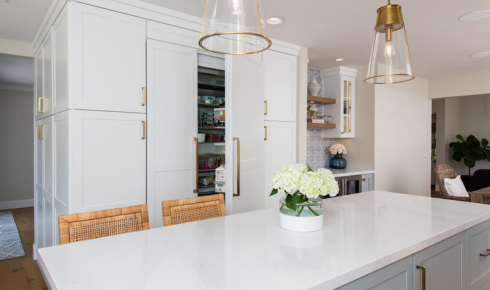Living by the coast in La Jolla or Point Loma offers gorgeous views, proximity to the waves, and ocean breezes. But that salt air is no friend to ordinary interiors. In the kitchen especially—near windows, appliances, sinks, and ventilation—materials face constant exposure to moisture, corrosive salts, and fluctuating temperatures. Over time, poor choices show damage: rusted hardware, warped woods, faded finishes, corroded metals, and failing seals.
At Sheiner Construction, we’ve built and remodeled many homes along San Diego’s coastline. We’ve learned what works (and what doesn’t) through real experience. In this guide, we’ll walk through durable, coastal-resistant materials ideal for kitchens in La Jolla, Point Loma, and other salt-air environments. You’ll see which materials perform best, trade-offs to consider, and how to detail them for long life. Let’s dive in.
Why Salt Air Demands Better Material Choices
Salt in the air acts like a slow-acting corrosive. When it lands on surfaces and gets trapped in crevices, it accelerates oxidation, chips away at protective coatings, and forces moisture deeper into materials. Metals rust faster, wood swells or warps more readily, and finishes peel or yellow over time.
For instance, cabinetry near the coast is especially vulnerable—hinges, screws, drawer tracks, and veneers all suffer more quickly than interiors farther from the water. One source warns: “Coastal air, filled with salt and moisture, … can lead to issues like warping, swelling, and rusted hardware.”
So for coastal kitchens, you can’t just pick what looks nice—you must pick for resilience. The right material choices reduce maintenance, extend life, and preserve beauty.
Cabinetry & Woodwork: Best Options for Coastal Kitchens
Marine-Grade or Moisture-Resistant Plywood & Core Materials
Rather than standard particleboard or MDF—which absorb moisture—opt for moisture-resistant plywood or marine-grade cores. These resist swelling and delamination better under humid, salty conditions.
Stable Hardwood Species + Protective Finishes
If you love wood, go with species known for dimensional stability (teak, mahogany, cedar, or engineered wood designed for wet climate). But even that isn’t enough alone. You must seal all edges, use UV-resistant topcoats, and regularly recoat surfaces to defend against moisture.
Avoid Exposed Wood at All Costs
Avoid leaving raw wood edges or surfaces unsealed—salt spray will creep in. All exposed wood must have a protective finish: clear sealers, varnishes, or coatings rated for marine conditions.
Hardware: Stainless Steel or Corrosion-Resistant Metals
Choose hardware, hinges, drawer slides, and fasteners in stainless steel (304 or 316 grade) or other corrosion-resistant alloys. These resist rusting far better than plating or lesser metals. The coastal environment is relentless on metals.
If metal is exposed, a protective powder coat or electroplated finish adds another barrier.
Example from outdoor kitchens
Outdoor/kitchen furniture manufacturers in coastal areas often recommend 316 (marine-grade) stainless steel cabinetry to resist salt.
While indoor kitchens may not endure direct exposure, the same principles apply near windows or in open spaces.
Countertops & Surfaces: What Holds Up Near Salt & Moisture
Solid Surface & Engineered Stone
High-quality engineered quartz (with low porosity) is a widely used choice. It resists staining, moisture penetration, and salt intrusion better than many natural stones—as long as the seam and edges are well sealed.
Porcelain & Sintered Slabs
Porcelain slabs or sintered stone options (like Dekton, Neolith, etc.) are excellent for coastal climates. They’re nonporous, UV-stable, chemically inert, and resist salt and moisture with minimal maintenance.
Granite & Natural Stone (with care)
Granite is durable, but it must be sealed well. In coastal areas, water and salt can penetrate micro-fissures unless you use impregnating sealers and reseal periodically.
Avoid softer or more porous stones (e.g., marble, limestone) in high exposure areas, because they absorb moisture, stain, and deteriorate faster.
Concrete & Terrazzo (sealed)
Concrete and terrazzo can be used if impermeable sealers are applied and maintained. But without strong coatings, they attract salt, stain, or crack prematurely under freeze-thaw or moisture cycles.
Backsplashes, Walls & Finishes
Glazed or Porcelain Tile
Choose glazed ceramic or porcelain tile for backsplashes: they are dense, nonporous, easy to clean, and resist salt deposits. Avoid unglazed terracotta or porous tiles in areas where splashing or humidity is likely.
Stainless Steel or Metal Splash Panels
Stainless steel backsplashes (304 or even 316 if budget allows) are elegant and extremely durable. Just remember to detail edges and joints properly so salt doesn’t infiltrate seams.
Glass, Laminates, and Other Composites
Tempered glass panels or high-pressure laminates (HPL) with protective coatings can work well above counters or behind stoves, provided they’re sealed at edges to resist salt intrusion.
Flooring & Underfoot Materials
Though often less directly exposed, kitchen floors near open windows or coastal breezes need to be robust:
- Porcelain tile (textured, non-slip) is a top performer.
- Luxury vinyl plank (LVP) made for wet areas (with waterproof core) is a good option if you want warmth underfoot.
- Engineered hardwood with a high-grade finish can work if it has proper sealing and acclimation—but choose species with excellent moisture stability.
Ventilation, Windows & Moisture Control
Choosing great materials is half the job; controlling moisture is the rest.
- Use vent hoods that exhaust outwards (not recirculating) to remove humid, salty air.
- Use well-sealed, marine-rated windows and doors that reduce salt intrusion.
- Employ dehumidifiers or HVAC systems designed to maintain lower indoor humidity.
- Install good flashing, sealants, and vapor barriers to protect backs of cabinets and hidden zones.
Detailing & Installation Best Practices
- Edge sealing: Seal all cabinet edges, backs, and cutouts with water-resistant sealers.
- Gasketed seams: Use gaskets or caulk in cabinet joints, base attachments, and edge overlaps to block salt intrusions.
- Elevated toe kicks and legs: Keep cabinet boxes raised off the floor on legs or toe kicks to allow airflow and prevent water pooling.
- Flush mount panels: Avoid flush tight seams to exterior surfaces—leave slight gaps or drip edges to let water run off.
- Regular maintenance: Rinse down surfaces and hardware periodically, inspect sealants, and recoat protective finishes.
Case Examples & Our Lessons from La Jolla / Point Loma Kitchen Remodel Projects
Over the years, we’ve done several coastal kitchen remodels in San Diego, along the La Jolla cliffs and Point Loma shoreline. A few lessons:
- Hinge corrosion was the first to show — in one early project, we saw stainless hinges turning discolored in under a year because we used a lower grade.
- Countertop seams failing — poorly sealed seams let salt water creep in and forced re-caulking.
- Unsealed cabinet interiors degraded faster — we now always seal the rear and underside of cabinet boxes, not just their visible faces.
- Open ventilation made a difference — kitchens with better airflow had far less visible salt staining or corrosion over time.
Using well-chosen materials and detailing prevented all of these issues in our newer builds.
Cost Considerations & ROI
Materials like marine-grade stainless steel, sintered stone, and marine-grade plywood carry a premium over standard options. But in coastal areas, the lifetime costs (maintenance, repair, replacement) often make them more cost-effective overall.
We advise clients to budget for the premium on critical zones (cabinets, hardware, countertops) while using more conventional options in low-exposure zones. The durability payback and reduced headache make it well worth it.
Conclusion
Designing a kitchen for coastal locations like La Jolla or Point Loma demands more than style—it demands substance. Materials that resist salt, moisture, humidity, and corrosion aren’t optional; they’re essential if you want that kitchen to last decades, not years.
At Sheiner Construction, we bring the coastal wisdom to every project. We select materials, design details, and installation strategies that prioritize durability in salt air. If you’re remodeling or building a kitchen in a coastal area, we’d be happy to guide you through the best material choices, detailing, and budgeting—so your investment stands strong against the sea breeze.
Who We Are?
We are Sheiner Construction, your San Diego coastal remodeling partner. With extensive hands-on experience in La Jolla, Point Loma, and other coastal neighborhoods, we specialize in designing, building, and protecting homes where the elements test every detail. From kitchens to full home upgrades, we combine craftsmanship, knowledge of local climate challenges, and thoughtful material selection to deliver lasting beauty and performance.
We don’t just build rooms — we build resilient homes. Let us help you make choices today that protect your home tomorrow, even when waves or salt air are never far off.


